PLL Frequency synthesizer tutorial
- an introduction to the indirect (phase locked loop
- pll) synthesizer
Today most receivers use a phase locked loop or PLL frequency
synthesizer. Many of them advertise this fact by displaying words like "PLL",
"Synthesized", or "Quartz" on their front panels or in the advertising
literature. Whatever one thinks of the sales language, PLL frequency
synthesizers offer tremendous advantages to the operation of a receiver. Not
only do frequency synthesizers enable receivers to have the same stability as
the quartz reference, but they also enable many other facilities to be
introduced because they can easily be controlled by a microprocessor. This
enables facilities such as multiple memories, keypad frequency entry, scanning
and much more to be incorporated into the set.
Phase locked loop, PLL, frequency synthesizers are widely
used, but their operation is not always well understood. One of the reasons for
this is that their design can involve some complicated math, but despite this
the basic concepts are relatively easy to grasp.
PLL Basics
A frequency synthesizer is based around a phase locked loop or PLL. This circuit
uses the idea of phase comparison as the basis of its operation. From the block
diagram of a basic loop shown in Fig. 1 it can be seen that there are three
basic circuit blocks, a phase comparator, voltage controlled oscillator, and
loop filter. A reference oscillator is sometimes included in the block diagram,
although this is not strictly part of the loop itself even though a reference
signal is required for its operation.
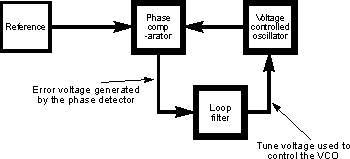
Block diagram of a basic phase locked loop (PLL)
The phase locked loop, PLL, operates by comparing the phase
of two signals. The signals from the voltage controlled oscillator and reference
enter the phase comparator Here a third signal equal to the phase difference
between the two input signals is produced.
The phase difference signal is then passed through the loop
filter. This performs a number of functions including the removal of any
unwanted products that are present on this signal. Once this has been
accomplished it is applied to the control terminal of the voltage controlled
oscillator. This tune voltage or error voltage is such that it tries to reduce
the error between the two signals entering the phase comparator. This means that
the voltage controlled oscillator will be pulled towards the frequency of the
reference, and when in lock there is a steady state error voltage. This is
proportional to the phase error between the two signals, and it is constant.
Only when the phase between two signals is changing is there a frequency
difference. As the phase difference remains constant when the loop is in lock
this means that the frequency of the voltage controlled oscillator is exactly
the same as the reference.
Synthesisizers
A phase locked loop, PLL, needs some additional circuitry if it is to be
converted into a frequency synthesizer. This is done by adding a frequency
divider between the voltage controlled oscillator and the phase comparator as
shown in Fig. 2.
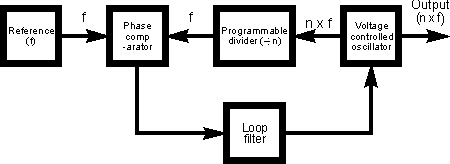
A programmable divider added into a phase locked loop,
PLL, enables the frequency to be changed.
Programmable dividers or counters are used in many areas of
electronics, including many radio frequency applications. They take in a pulse
train like that shown in Fig. 3, and give out a slower train. In a divide by two
circuit only one pulse is given out for every two that are fed in and so forth.
Some are fixed, having only one division ratio. Others are programmable and
digital or logic information can be fed into them to set the division ratio.
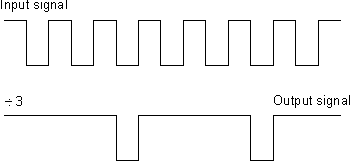
Operation of a programmable divider
When the divider is added into the circuit the phase locked
loop, PLL, still tries to reduce the phase difference between the two signals
entering the phase comparator. Again when the circuit is in lock both
signals entering the comparator are exactly the same in frequency. For this to
be true the voltage controlled oscillator must be running at a frequency equal
to the phase comparison frequency times the division ratio.
It can be seen that if the division ratio is altered by one,
then the voltage controlled oscillator will have to change to the next multiple
of the reference frequency. This means that the step frequency of the
synthesizer is equal to the frequency entering the comparator.
Most synthesizers need to be able to step in much smaller
increments if they are to be of any use. This means that the comparison
frequency must be reduced. This is usually accomplished by running the reference
oscillator at a frequency of a megahertz or so, and then dividing this signal
down to the required frequency using a fixed divider. In this way a low
comparison frequency can be achieved.
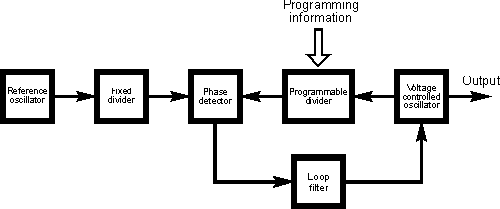
Comparison frequency reduced by adding a fixed divider
after the reference oscillator
Analogue Techniques
Placing a digital divider is not the only method of making a synthesizer using a
phase locked loop, PLL. It is also possible to use a mixer in the loop as shown
in Fig. 5. Using this technique places an offset into the frequency generated by
the loop.
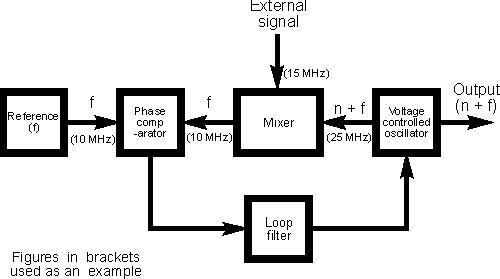
A phase locked loop, PLL, with mixer
The way in which the phase locked loop, PLL, operates with
the mixer incorporated can be analyzed in the same manner that was used for the
loop with a divider. When the loop is in lock the signals entering the phase
detector are at exactly the same frequencies. The mixer adds an offset equal to
the frequency of the signal entering the other port of the mixer. To illustrate
the way this operates figures have been included. If the reference oscillator is
operating at a frequency of 10 MHz and the external signal is at 15 MHz then the
VCO must operate at either 5 MHz or 25 MHz.. Normally the loop is set up so that
mixer changes the frequency down and if this is the case then the oscillator
will be operating at 25 MHz.
It can be seen that there may be problems with the
possibility of two mix products being able to give the correct phase comparison
frequency. It happens that as a result of the phasing in the loop, only one will
enable it to lock. However to prevent the loop getting into an unwanted state
the range of the VCO is limited. For phase locked loops, PLLs, that need to
operate over a wide range a steering voltage is added to the main tune voltage
so that the frequency of the loop is steered into the correct region for
required conditions. It is relatively easy to generate a steering voltage by
using digital information from a microprocessor and converting this into an
analogue voltage using a digital to analogue converter (DAC). The fine tune
voltage required to pull the loop into lock is provided by the loop in the
normal way.
Multi-loop synthesizers
Many high performance synthesizers use several loops that incorporate both
mixers and digital dividers. By using these techniques it is possible to produce
high performance wide range signal sources with very small step sizes. If only a
single loop is used then there may be short falls in the level of performance.
There is a large variety of ways in which multi-loop
synthesizers can be made, dependent upon the requirements of the individual
system. However as an illustration a two loop system is shown in Fig. 6. This
uses one loop to give the smaller steps and the second provides larger steps.
This principle can be expanded to give wider ranges and smaller steps.
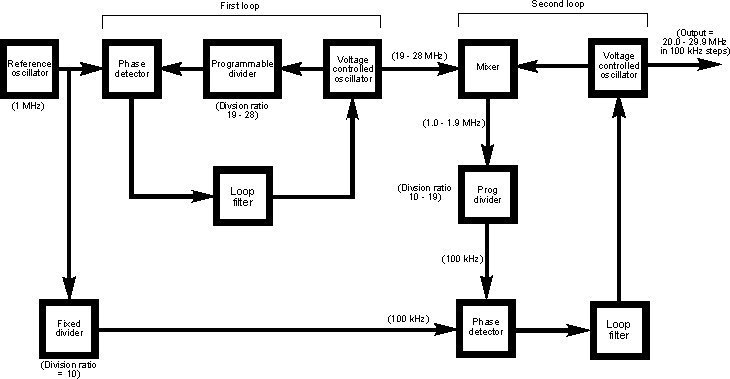
An example of a synthesizer using two loops
The first phase locked loop, PLL, has a digital divider and
operates over the range 19 to 28 MHz. Having a reference frequency of 1 MHz it
provides steps of 1 MHz. The signal from this loop is fed into the mixer of the
second one. The second loop has division ratios of 10 to 19, but as the
reference frequency has been divided by 10 to 100 kHz to give smaller steps.
The operation of the whole loop can be examined by looking at
extremes of the frequency range. With the first loop set to its lowest value the
divider is set to 19 and the output from the loop is at 19 MHz. This feeds into
the second loop. Again this is set to the minimum value and the frequency after
the mixer must be at 1.0 MHz. With the input from the first loop at 19 MHz this
means that the VCO must operate at 20 MHz if the loop is to remain in lock.
At the other end of the range the divider of the first loop
is set to 28, giving a frequency of 28 MHz. The second phase locked loop, PLL,
has the divider set to 19, giving a frequency of 1.9 MHz between the mixer and
divider. In turn this means that the frequency of the VCO must operate at 29.9
MHz. As the phase locked loops, PLLs, can be stepped independently it means that
the whole synthesizer can move in steps of 100 kHz between the two extremes of
frequency. As mentioned before this principle can be extended to give greater
ranges and smaller steps, providing for the needs of modern receivers.
|

